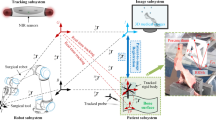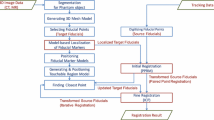Abstract
Purpose
We present a registration method for computer-assisted total hip replacement (THR) surgery, which we demonstrate to improve the state of the art by both reducing the invasiveness of current methods and increasing registration accuracy. A critical element of computer-guided procedures is the determination of the spatial correspondence between the patient and a computational model of patient anatomy. The current method for establishing this correspondence in robot-assisted THR is to register points intraoperatively sampled by a tracked pointer from the exposed proximal femur and, via auxiliary incisions, from the distal femur.
Methods
In this paper, we demonstrate a noninvasive technique for sampling points on the distal femur using tracked B-mode ultrasound imaging and present a new algorithm for registering these data called Projected Iterative Most-Likely Oriented Point (P-IMLOP). Points and normal orientations of the distal bone surface are segmented from ultrasound images and registered to the patient model along with points sampled from the exposed proximal femur via a tracked pointer.
Results
The proposed approach is evaluated using a bone- and tissue-mimicking leg phantom constructed to enable accurate assessment of experimental registration accuracy with respect to a CT-image-based model of the phantom. These experiments demonstrate that localization of the femur shaft is greatly improved by tracked ultrasound. The experiments further demonstrate that, for ultrasound-based data, the P-IMLOP algorithm significantly improves registration accuracy compared to the standard ICP algorithm.
Conclusion
Registration via tracked ultrasound and the P-IMLOP algorithm has high potential to reduce the invasiveness and improve the registration accuracy of computer-assisted orthopedic procedures.





Similar content being viewed by others
References
Garbini J, Kaiura R, Sidles J, Larson R, Matsen F (1987) Robotic instrumentation in total knee arthroplasty. In: 33rd Annual meeting, orthopaedic research society
Paul HA, Bargar WL, Mittelstadt B, Musits B, Taylor RH, Kazanzides P, Zuhars J, Williamson B, Hanson W (1992) Development of a surgical robot for cementless total hip arthroplasty. Clin Orthop Relat Res 285:57–66
Taylor R, Mittelstadt B, Paul H, Hanson W, Kazanzides P, Zuhars J, Williamson B, Musits B, Glassman E, Bargar W (1994) An image-directed robotic system for precise orthopaedic surgery. IEEE Trans Robot Autom 10:261–275
Kazanzides P, Zuhars J, Mittelstadt B, Taylor R (1992) Force sensing and control for a surgical robot. In: IEEE International conference on robotics and automation. pp 612–617
Nogler M, Maurer H, Wimmer C, Gegenhuber C, Bach C, Krismer M (2001) Knee pain caused by a fiducial marker in the medial femoral condyle: a clinical and anatomic study of 20 cases. Acta Orthop 72:477–480
Cohan S (2001) ROBODOC achieves pinless registration. Int J Ind Robot 28:381–386
Guéziec A, Kazanzides P, Williamson B, Taylor RH (1998) Anatomy-based registration of ct-scan and intraoperative x-ray images for guiding a surgical robot. IEEE Trans Med Imaging 17:715–728
LaRose D, Bayouth J, Kanade T (2000) Transgraph: interactive intensity-based 2d/3d registration of x-ray and ct data. In: Hanson KM (ed) SPIE medical imaging 2000: image processing, vol 3979, pp 385–396
Otake Y, Armand M, Armiger RS, Kutzer MD, Basafa E, Kazanzides P, Taylor RH (2012) Intraoperative image-based multiview 2d/3d registration for image-guided orthopaedic surgery: incorporation of fiducial-based C-arm tracking and GPU-acceleration. IEEE Trans Med Imaging 31:948–962
Sahay A, Witherspoon L, Bargar W (2004) Computer model-based study for minimally invasive THR femoral cavity preparation using the ROBODOC system. In: Computer Assisted Orthopaedic Surgery (CAOS). pp 314–316
Maurer CR, Gaston RP, Hill DLG, Gleeson MJ, Taylor MG, Fenlon MR, Edwards PJ, Hawkes DJ (1999) AcouStick: a tracked A-mode ultrasonography system for registration in image-guided surgery. In: Taylor C, Colchester A (eds) Medical image computing and computer-assisted intervention—MICCAI’99, pp 953–962
Amin DV, Kanade T, DiGioia AM, Jaramaz B (2003) Ultrasound registration of the bone surface for surgical navigation. Comput Aided Surg 8:1–16
Chen TK, Abolmaesumi P, Pichora DR, Ellis RE (2005) A system for ultrasound-guided computer-assisted orthopaedic surgery. Comput Aided Surg 10:281–292
Barratt D, Penney G, Chan C, Slomczykowski M, Carter T, Edwards P, Hawkes D (2006) Self-calibrating 3D-ultrasound-based bone registration for minimally invasive orthopedic surgery. IEEE Trans Med Imaging 25:312–323
Foroughi P, Boctor E, Swartz M, Taylor R, Fichtinger G (2007) Ultrasound bone segmentation using dynamic programming. In: IEEE ultrasonics symposium. pp 2523–2526
Kowal J, Amstutz C, Langlotz F, Talib H, Ballester MG (2007) Automated bone contour detection in ultrasound B-mode images for minimally invasive registration in computer-assisted surgery-an in vitro evaluation. Int J Med Robot Comput Assist Surg 3:341–348
Hacihaliloglu I, Wilson DR, Gilbart M, Hunt MA, Abolmaesumi P (2013) Non-iterative partial view 3d ultrasound to ct registration in ultrasound-guided computer-assisted orthopedic surgery. Int J Comput Assist Radiol Surg 8:157–168
Gonçalves P, Torres P, Santos F, António R, Catarino N, Martins J (2015) A vision system for robotic ultrasound guided orthopaedic surgery. J Intell Robot Syst 77:327–329
Jain AK, Taylor RH (2004) Understanding bone responses in B-mode ultrasound images and automatic bone surface extraction using a bayesian probabilistic framework. In: Walker WF, Emelianov SY (eds) SPIE medical imaging 2004: ultrasonic imaging and signal processing, vol 5373, pp 131–142
Daanen V, Tonetti J, Troccaz J (2004) A fully automated method for the delineation of osseous interface in ultrasound images. In: Barillot C, Haynor DR, Hellier P (eds) Medical image computing and computer-assisted intervention—MICCAI 2004, pp 549–557
Billings S, Taylor R (2014) Iterative most likely oriented point registration. In: Golland P, Hata N, Barillot C, Hornegger J, Howe R (eds) Medical image computing and computer-assisted intervention—MICCAI 2014, pp 178–185
Besl P, McKay ND (1992) A method for registration of 3-d shapes. IEEE Trans Pattern Anal Mach Intell 14:239–256
Guo X, Cheng A, Zhang HK, Kang HJ, Etienne-Cummings R, Boctor EM (2014) Active echo: a new paradigm for ultrasound calibration. In: Golland P, Hata N, Barillot C, Hornegger J, Howe R (eds) Medical image computing and computer-assisted intervention—MICCAI 2014, pp 397–404
Cheng A, Guo X, Zhang HK, Kang HJ, Etienne-Cummings R, Boctor EM (2015) Active point out-of-plane ultrasound calibration. In: Yaniv ZR, Webster RJ (eds) SPIE medical imaging 2015: image-guided procedures, robotic interventions, and modeling, vol 9415. http://proceedings.spiedigitallibrary.org/volume.aspx?volumeid=17053 (in press)
Estépar RSJ, Brun A, Westin CF (2004) Robust generalized total least squares iterative closest point registration. In: Barillot C, Haynor DR, Hellier P (eds) Medical image computing and computer-assisted intervention—MICCAI 2004, pp 234–241
Segal A, Haehnel D, Thrun S (2009) Generalized-icp. In: Robotics: science and systems. http://www.roboticsproceedings.org/rss05/21.html
Maier-Hein L, Franz AM, dos Santos TR, Schmidt M, Fangerau M, Meinzer H, Fitzpatrick JM (2012) Convergent iterative closest-point algorithm to accommodate anisotropic and inhomogeneous localization error. IEEE Trans Pattern Anal Mach Intell 34:1520–1532
Billings S, Boctor E, Taylor R (2015) Iterative most-likely point registration (imlp): a robust algorithm for computing optimal shape alignment. PLoS One 10:e0117688 doi:10.1371/journal.pone.0117688
Moghari MH, Abolmaesumi P (2007) Point-based rigid-body registration using an unscented Kalman filter. IEEE Trans Med Imaging 26:1708–1728
Pulli K (1999) Multiview registration for large data sets. In: Second international conference on 3-D digital imaging and modeling, pp 160–168
Lara C, Romero L, Caldern F (2008) A robust iterative closest point algorithm with augmented features. In: Gelbukh A, Morales EF (eds) MICAI 2008: advances in artificial intelligence, pp 605–614
Kang X, Armand M, Otake Y, Yau WP, Cheung P, Hu Y, Taylor R (2014) Robustness and accuracy of feature-based single image 2d–3d registration without correspondences for image-guided intervention. IEEE Trans Biomed Eng 61:149–161
Baka N, Metz C, Schultz C, van Geuns RJ, Niessen W, van Walsum T (2014) Oriented gaussian mixture models for non-rigid 2d/3d coronary artery registration. IEEE Trans Med Imaging 33:1023–1034
Bushberg JT, Seibert JA, Leidholdt EM Jr, Boone JM (2011) The essential physics of medical imaging, 3rd edn. Lippincott Williams & Wilkins, Philadelphia
Mardia K, Jupp P (2000) Directional statistics. Wiley, Hoboken
Verma N, Kpotufe S, Dasgupta S (2009) Which spatial partition trees are adaptive to intrinsic dimension? In: UAI ’09 proceedings of the twenty-fifth conference on uncertainty in artificial intelligence, pp 565–574
Larsson T (2008) An efficient ellipsoid-obb intersection test. J Graph GPU Game Tools 13:31–43
King DE (2009) Dlib-ml: a machine learning toolkit. J Mach Learn Res 10:1755–1758
Integrated Surgical Systems (1999) \(\text{ ROBODOC }^{\textregistered }\) User Manual
Acknowledgments
Support and funding for this work was provided by the National Science Foundation Graduate Research Fellowship Program, Johns Hopkins Internal Funds, and THINK Surgical, Inc.
Conflict of interest
Emad Boctor, Peter Kazanzides, and Russell Taylor have a grant from THINK Surgical, Inc. The authors declare that they have no other conflict of interest.
Author information
Authors and Affiliations
Corresponding author
Rights and permissions
About this article
Cite this article
Billings, S., Kang, H.J., Cheng, A. et al. Minimally invasive registration for computer-assisted orthopedic surgery: combining tracked ultrasound and bone surface points via the P-IMLOP algorithm. Int J CARS 10, 761–771 (2015). https://doi.org/10.1007/s11548-015-1188-z
Received:
Accepted:
Published:
Issue Date:
DOI: https://doi.org/10.1007/s11548-015-1188-z




